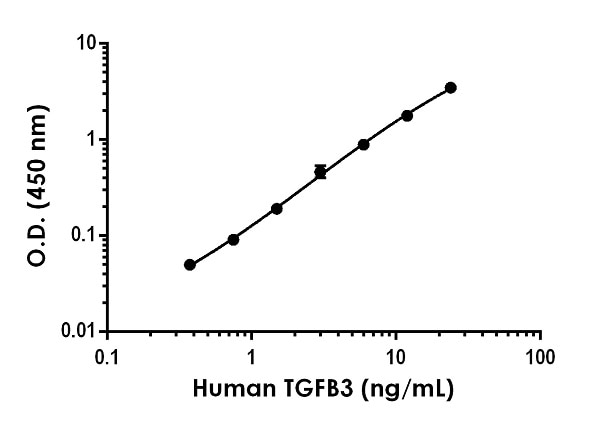Human TGFB3 ELISA Kit (ab272203)
Key features and details
- One-wash 90 minute protocol
- Sensitivity: 0.038 ng/ml
- Range: 0.38 ng/ml - 24 ng/ml
- Sample type: Cell culture media, Tissue Extracts
- Detection method: Colorimetric
- Assay type: Sandwich (quantitative)
- Reacts with: Human
Overview
-
Product name
Human TGFB3 ELISA Kit
See all TGF beta 3 kits -
Detection method
Colorimetric -
Precision
Intra-assay Sample n Mean SD CV% Extract 8 5.2% Inter-assay Sample n Mean SD CV% Extract 3 11.1% -
Sample type
Tissue Extracts, Cell culture media -
Assay type
Sandwich (quantitative) -
Sensitivity
0.038 ng/ml -
Range
0.38 ng/ml - 24 ng/ml -
Recovery
Sample specific recovery Sample type Average % Range Tissue Extracts 91 86% - 96% Cell culture media 100 89% - 107% -
Assay time
1h 30m -
Assay duration
One step assay -
Species reactivity
Reacts with: Human -
Product overview
Human TGFB3 ELISA kit (ab272200) is a single-wash 90 min sandwich ELISA designed for the quantitative measurement of TGFB3 protein in cell culture supernatant and cell and tissue extracts. It uses our proprietary SimpleStep ELISA® technology. Quantitate Human TGFB3 with 0.038 ng/mL sensitivity.
SimpleStep ELISA® technology employs capture antibodies conjugated to an affinity tag that is recognized by the monoclonal antibody used to coat our SimpleStep ELISA® plates. This approach to sandwich ELISA allows the formation of the antibody-analyte sandwich complex in a single step, significantly reducing assay time. See the SimpleStep ELISA® protocol summary in the image section for further details. Our SimpleStep ELISA® technology provides several benefits:
-Single-wash protocol reduces assay time to 90 minutes or less
-High sensitivity, specificity and reproducibility from superior antibodies
-Fully validated in biological samples
-96-wells plate breakable into 12 x 8 wells strips
A 384-well SimpleStep ELISA® microplate (ab203359) is available to use as an alternative to the 96-well microplate provided with SimpleStep ELISA® kits.
-
Notes
Transforming growth factor beta-3 is a cytokine encoded by the TGFB3 gene. TGFB3 belongs to a larger family of proteins known as the transforming growth factor beta superfamily, which includes TGFB1 and 2, bone morphogenetic proteins, Growth Differentiation factors, inhibins and activins. TGFB3 is expressed as a proprotein containing a 277- amino acid latency-associated peptide (LAP) that remains non-covalently associated with TGFB3 after cleavage by the Golgi apparatus. Interaction with integrins removes the LAP, thus releasing a 112- amino acid active TGFB3. Active TGFB3 has many functions, including regulation of the embryogenesis and secondary palate development cell differentiation. The standard protein in this product is the active sequence of TGFB3.
Abcam has not and does not intend to apply for the REACH Authorisation of customers’ uses of products that contain European Authorisation list (Annex XIV) substances.
It is the responsibility of our customers to check the necessity of application of REACH Authorisation, and any other relevant authorisations, for their intended uses. -
Platform
Pre-coated microplate (12 x 8 well strips)
Properties
-
Storage instructions
Store at +4°C. Please refer to protocols. -
Components 1 x 96 tests 10X Human TGFB3 Capture Antibody 1 x 600µl 10X Human TGFB3 Detector Antibody 1 x 600µl 10X Wash Buffer PT (ab206977) 1 x 20ml 50X Cell Extraction Enhancer Solution (ab193971) 1 x 1ml 5X Cell Extraction Buffer PTR (ab193970) 1 x 10ml Antibody Diluent 5BI 1 x 6ml Human TGFB3 Lyophilized Recombinant Protein 2 vials Plate Seals 1 unit Sample Diluent NS (ab193972) 1 x 12ml SimpleStep Pre-Coated 96-Well Microplate (ab206978) 1 unit Stop Solution 1 x 12ml TMB Development Solution 1 x 12ml -
Research areas
-
Function
Involved in embryogenesis and cell differentiation. -
Involvement in disease
Defects in TGFB3 are a cause of familial arrhythmogenic right ventricular dysplasia type 1 (ARVD1) [MIM:107970]; also known as arrhythmogenic right ventricular cardiomyopathy 1 (ARVC1). ARVD is an autosomal dominant disease characterized by partial degeneration of the myocardium of the right ventricle, electrical instability, and sudden death. It is clinically defined by electrocardiographic and angiographic criteria; pathologic findings, replacement of ventricular myocardium with fatty and fibrous elements, preferentially involve the right ventricular free wall. -
Sequence similarities
Belongs to the TGF-beta family. -
Cellular localization
Secreted. - Information by UniProt
-
Alternative names
- ARVD
- ARVD1
- FLJ16571
see all -
Database links
- Entrez Gene: 7043 Human
- Omim: 190230 Human
- SwissProt: P10600 Human
- Unigene: 592317 Human
Images
-
SimpleStep ELISA technology allows the formation of the antibody-antigen complex in one single step, reducing assay time to 90 minutes. Add samples or standards and antibody mix to wells all at once, incubate, wash, and add your final substrate. See protocol for a detailed step-by-step guide.
-
The TGFB3 standard curve was prepared as described in Section 10. Raw data values are shown in the table. Background-subtracted data values (mean +/- SD) are graphed.
-
Interpolated concentrations of spiked TGFB3 in human heart extract and RPMI cell culture media samples.
The concentrations of TGFB3 were measured in duplicates, interpolated from the TGFB3 standard curves and corrected for sample dilution. Undiluted samples are as follows: heart extract 100 µg/mL, 50% RPMI containing 10% FBS. The interpolated dilution factor corrected values are plotted (mean +/- SD, n=2).
-
To learn more about the advantages of recombinant antibodies see here.










